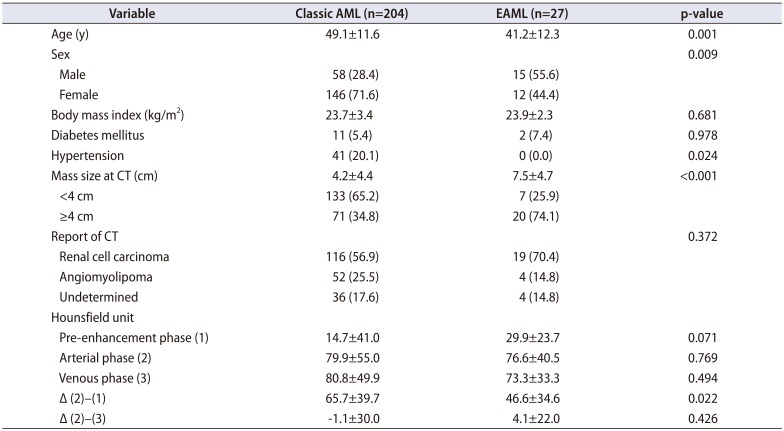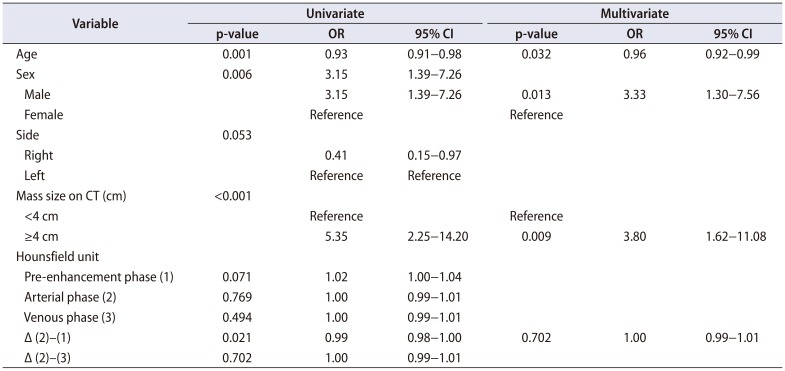1. Neumann HP, Schwarzkopf G, Henske EP. Renal angiomyolipomas, cysts, and cancer in tuberous sclerosis complex. Semin Pediatr Neurol. 1998; 5:269–275. PMID:
9874854.

2. Aydin H, Magi-Galluzzi C, Lane BR, Sercia L, Lopez JI, Rini BI, et al. Renal angiomyolipoma: clinicopathologic study of 194 cases with emphasis on the epithelioid histology and tuberous sclerosis association. Am J Surg Pathol. 2009; 33:289–297. PMID:
18852677.
3. Armah HB, Parwani AV. Perivascular epithelioid cell tumor. Arch Pathol Lab Med. 2009; 133:648–654. PMID:
19391667.

4. He W, Cheville JC, Sadow PM, Gopalan A, Fine SW, Al-Ahmadie HA, et al. Epithelioid angiomyolipoma of the kidney: pathological features and clinical outcome in a series of consecutively resected tumors. Mod Pathol. 2013; 26:1355–1364. PMID:
23599151.

5. Brimo F, Robinson B, Guo C, Zhou M, Latour M, Epstein JI. Renal epithelioid angiomyolipoma with atypia: a series of 40 cases with emphasis on clinicopathologic prognostic indicators of malignancy. Am J Surg Pathol. 2010; 34:715–722. PMID:
20410812.

6. Varma S, Gupta S, Talwar J, Forte F, Dhar M. Renal epithelioid angiomyolipoma: a malignant disease. J Nephrol. 2011; 24:18–22. PMID:
20349413.

7. Martignoni G, Pea M, Bonetti F, Brnelli M, Eble JN. Oncocytoma-like angiomyolipoma. A clinicopathologic and immunohistochemical study of 2 cases. Arch Pathol Lab Med. 2002; 126:610–612. PMID:
11958671.
8. Mai KT, Perkins DG, Collins JP. Epithelioid cell variant of renal angiomyolipoma. Histopathology. 1996; 28:277–280. PMID:
8729052.

9. Lei JH, Liu LR, Wei Q, Song TR, Yang L, Yuan HC, et al. A four-year follow-up study of renal epithelioid angiomyolipoma: a multi-center experience and literature review. Sci Rep. 2015; 5:10030. PMID:
25939249.

10. Lopez-Beltran A, Scarpelli M, Montironi R, Kirkali Z. 2004 WHO classification of the renal tumors of the adults. Eur Urol. 2006; 49:798–805. PMID:
16442207.

11. Faraji H, Nguyen BN, Mai KT. Renal epithelioid angiomyolipoma: a study of six cases and a meta-analytic study. Development of criteria for screening the entity with prognostic significance. Histopathology. 2009; 55:525–534. PMID:
19912358.

12. Lavrut PM, Paparel P, Decaussin-Petrucci M. Epithelioid angiomyolipoma of the kidney: about one case and malignant features evaluation. Ann Pathol. 2017; 37:182–187. PMID:
28318774.
13. Nese N, Martignoni G, Fletcher CD, Gupta R, Pan CC, Kim H, et al. Pure epithelioid PEComas (so-called epithelioid angiomyolipoma) of the kidney: a clinicopathologic study of 41 cases: detailed assessment of morphology and risk stratification. Am J Surg Pathol. 2011; 35:161–176. PMID:
21263237.
14. Huang KH, Huang CY, Chung SD, Pu YS, Shun CT, Chen J. Malignant epithelioid angiomyolipoma of the kidney. J Formos Med Assoc. 2007; 106(2 Suppl):S51–S54. PMID:
17493897.

15. Yamamoto T, Ito K, Suzuki K, Yamanaka H, Ebihara K, Sasaki A. Rapidly progressive malignant epithelioid angiomyolipoma of the kidney. J Urol. 2002; 168:190–191. PMID:
12050523.

16. Adanur S, Keskin E, Ziypak T, Koc E, Demirci E, Yapanoglu T, et al. Renal epithelioid angiomyolipoma mimicking urothelial carcinoma of the upper urinary tract. Arch Ital Urol Androl. 2014; 86:235–236. PMID:
25308597.

17. Folpe AL, Kwiatkowski DJ. Perivascular epithelioid cell neoplasms: pathology and pathogenesis. Hum Pathol. 2010; 41:1–15. PMID:
19604538.

18. Liu Y, Qu F, Cheng R, Ye Z. CT-imaging features of renal epithelioid angiomyolipoma. World J Surg Oncol. 2015; 13:280. PMID:
26391670.

19. Zhu J, Li H, Ding , L , Cheng H. Imaging appearance of renal epithelioid angiomyolipoma: a case report and literature review. Medicine (Baltimore). 2018; 97:e9563. PMID:
29505538.
20. Cibas ES, Goss GA, Kulke MH, Demetri GD, Fletcher CD. Malignant epithelioid angiomyolipoma (‘sarcoma ex angiomyolipoma’) of the kidney: a case report and review of the literature. Am J Surg Pathol. 2001; 25:121–126. PMID:
11145246.
21. Park HK, Zhang S, Wong MK, Kim HL. Clinical presentation of epithelioid angiomyolipoma. Int J Urol. 2007; 14:21–25. PMID:
17199855.

22. Benson C, Vitfell-Rasmussen J, Maruzzo M, Fisher C, Tunariu N, Mitchell S, et al. A retrospective study of patients with malignant PEComa receiving treatment with sirolimus or temsirolimus: the royal marsden hospital experience. Anticancer Res. 2014; 34:3663–3668. PMID:
24982384.








 PDF
PDF ePub
ePub Citation
Citation Print
Print



 XML Download
XML Download